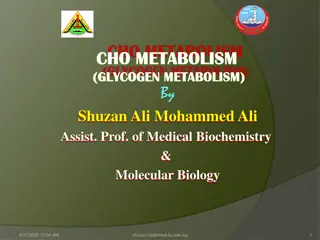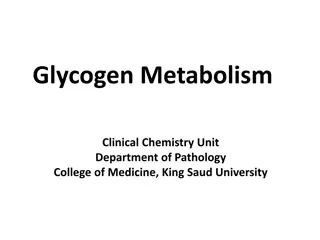
Understanding Glycogenesis: Process, Regulation, and Importance
Glycogenesis is the process of synthesizing glycogen from glucose for storage purposes in the body. This article explores the definition, introduction, process, and regulation of glycogenesis, highlighting its significance in energy storage and utilization.
Download Presentation

Please find below an Image/Link to download the presentation.
The content on the website is provided AS IS for your information and personal use only. It may not be sold, licensed, or shared on other websites without obtaining consent from the author. If you encounter any issues during the download, it is possible that the publisher has removed the file from their server.
You are allowed to download the files provided on this website for personal or commercial use, subject to the condition that they are used lawfully. All files are the property of their respective owners.
The content on the website is provided AS IS for your information and personal use only. It may not be sold, licensed, or shared on other websites without obtaining consent from the author.
E N D
Presentation Transcript
StudyMafia.Org Glycogenesis Submitted Studymafia.org Studymafia.org Submitted To: To: Submitted Submitted By: By: Studymafia.org Studymafia.org
Table Contents Definition Introduction Process of Glycogenesis Regulation of Glycogenesis Conclusion 2
Definition Glycogenesis can be defined as the process through which glycogen is synthesised and glucose molecules are added to the glycogen chains for storage purposes. 3
Introduction The biological mechanism of producing glycogen from glucose (which is the simplest cellular sugar) is generally referred to as glycogenesis. Via the glycogenesis phase, the body is known to generate glycogen in order to preserve these molecules for later use (for a time when the body does not have glucose readily accessible). It is important to note that glycogen is not the same as fat that is processed for energy in the long term. 4
Process of Glycogenesis It is important for the cell to have an excess of glucose in order to commence the process of glycogenesis. Glucose is known to be the starting molecule for the glycogenesis process. The process of glycogenesis is known to begin when a signal from the body to commence glycogenesis is received by cell. It is important to note that these signals could come from a variety of different routes. 5
Process of Glycogenesis Initially, in the process of glycogenesis, the glucose molecule is known to interact with the glucokinase enzyme (which is an enzyme that adds to the glucose a group of phosphates). The phosphate group is moved to the other side of the molecule, with the help of the enzyme phosphoglucomutase, in the next step of the glycogenesis process. 6
Process of Glycogenesis UDP-glucose pyrophosphorylase, which is another enzyme that is involved in this process, takes this molecule and produces glucose uracil- diphosphate. There are two phosphate groups in this glucose form, along with the nucleic acid uracil. Such additions help to build a chain of molecules, which is vital for the next step of the glycogenesis process. 7
Process of Glycogenesis In the final stage of the glycogenesis process, a very important enzyme known as glycogenin plays a vital role. By attaching itself to this specific molecule, the UDP-diphosphate glucose tends to form relatively short chains. More enzymes facilitate the completion of the process after approximately eight of these molecules form a chain together. 8
Process of Glycogenesis This chain is then added to glycogen synthase. Simultaneously, the enzyme responsible for glycogen branching helps to build branches in the chains. This results in a fairly compact macromolecule that is quite efficient in storing energy. 9
Regulation of Glycogenesis Via the process of phosphorylation, glycogen phosphorylase is known to be activated while glycogen synthase is known to be inhibited. Glycogen phosphorylase is generally transformed by the enzyme known as phosphorylase kinase from its relatively less reactive b form to a relatively more reactive a form. 10
Regulation of Glycogenesis Phosphorylase kinase is also known to be activated by the protein kinase A. Furthermore, phosphoprotein phosphatase-1 is known to be deactivated by the same protein. The hormone adrenaline acts to stimulate the protein kinase A. Furthermore, the hormone epinephrine binds itself to an adenylate cyclase- activating receptor protein. 11
Regulation of Glycogenesis This enzyme also allows ATP to form cyclic AMP. Two cyclic AMP molecules tend to bind to the kinase A regulatory subunit, which activates it. This allows the protein kinase A catalytic subunit to dissociate from the assembly and to subject other proteins to phosphorylation. Not only does epinephrine activate glycogen phosphorylase, it also contributes towards the inhibition of glycogen synthase. 12
Regulation of Glycogenesis The effect of activating glycogen phosphorylase is amplified by this. This occurs as the protein kinase A acts to subject the enzyme to phosphorylation (which decreases its activity). This is commonly referred to as coordinate reciprocal control. 13
Conclusion Glycogenesis, the formation of glycogen, the primary carbohydrate stored in the liver and muscle cells of animals, from glucose. Glycogenesis takes place when blood glucose levels are sufficiently high to allow excess glucose to be stored in liver and muscle cells. 14


